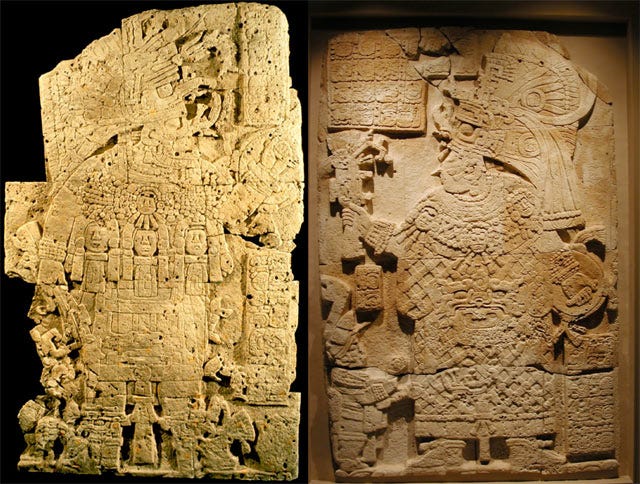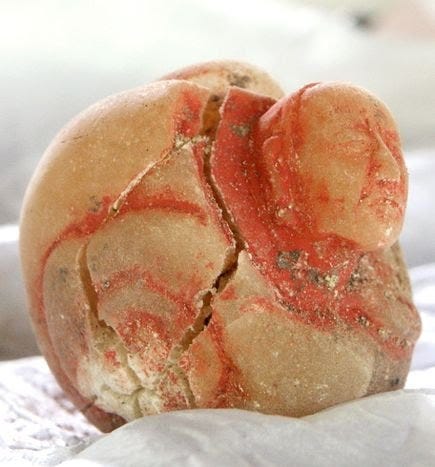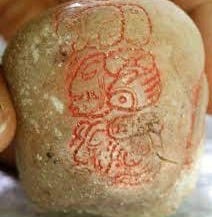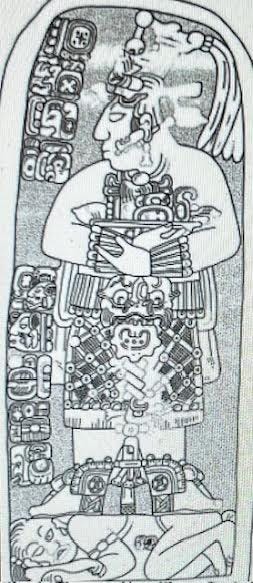The Maya Revered Powerful Women— Warrior Queens of the Yucatán, Part 2
Introducing the greatest ruler of the Late Classic period—Supreme Warlord Lady K'abel

Hola Amigos! Here’s Part 2 of Maya warrior queens and their emerging spot on the Maya stage thanks to enterprising archeologists. With two strikes against them—the impenetrable Maya code, unbroken until mid 1970s, and the unlikeliness of their very existence—off-the-grid pyramid sites have led explorers to remarkable discoveries. Finding a ‘white soul flower jar’ was key to the recognition of this particular warrior queen’s status. So please, dive right in!
Until fifteen years ago, Maya warrior queens were not the stuff of conversation much less legend in archeological circles. The idea was too far-fetched. The Maya hieroglyphic code had only been broken a few decades earlier in the 1970s at the now famous Palenque Round Table talks in southern Mexico.
Dozens of the world's finest archeologists and scholars gathered there, putting their heads together to try and break the enigmatic code. Besides that, hundreds of Maya sites had yet to be excavated. No one had a clue to how many sites were still out there buried in Yucatán’s teeming jungles.
But in 2004, everything changed. Archelogist Kathryn Reese-Taylor, University of Calgary, headed a dig at a relatively unknown site, Naachtun. Sitting between Tikal and Calakmul in the Yucatán lowlands of southern Mexico and northern Guatemala, Reese-Taylor and her team spent three months excavating the area. Their search proved fruitful and uncovered Lady Yohl Ik'nal, the Maya's first recorded female ruler, in 623 CE. (See Maya Warrior Queens, Part 1 (September 20). 1
Maya queens continued their rise to power in Yucatán’s central lowlands after a seismic geo-political shift occurred in the mid seventh century. Could Lady Yohl Ik’nal’s status as first female ruler at Naachtun been a precursor for other Maya cities to follow suit?
Enter Lady K’abel
In 2012 archeologists discovered the royal tomb of Lady K'abel, queen of the abandoned city El Perú-Waka', located between power houses Calakmul and Tikal in northern Guatemala. Known as the Centipede Kingdom, it played second fiddle to Calakmul, Snake Kingdom, its closest neighbor.
In an age old political gambit, Lady K'abel, daughter of the ruler of Calakmul, was married to Tikal's ruler Kinich Balam II to serve as governor of El Perú-Waka' on her father's behalf. Archeologist Olivia Farr-Navarro (College of Wooster), one of the team leaders, said they excavated her royal burial site that was located beneath a stairway platform at the foot of the main pyramid temple.
Highest power in the kingdom—Lady K’abel
Until this discovery, scholars had known Lady K'abel primarily as the Kaloomte', a Maya high king or queen who serves as military leader, the highest power in the kingdom. But Lady K'abel was hardly anonymous to those who studied the Maya. She had previously been identified by a stela (limestone slab in front of a pyramid) on display at the Cleveland Art Museum (opening photo) known as Stela 34 of El Perú. In it, she is shown as a queen in warrior dress.
The investigation of the stairway platform started long before 2006 when Farr-Navrro studied under archeologist and noted author David Freidel, Washington University in St. Louis, who wrote Forest of Kings and Maya Cosmos with Linda Schele. Co-director of the site with Freidel was Guatemala's Juan Carlos Pérez. In excavating El Perú-Waka', Freidel planned to not simply uncover tombs, but to focus on studying "ritually-charged" features such as shrines, altars, and dedicatory offerings.
Center of rituals and sacrifices
The city had long been a center for rituals and sacrifice, and signs implied it retained that presence long after 900 CE (the post-collapse era of the Maya) when kings no longer ruled.
Though a ‘stairway platform’ hardly seems a respectable landing spot for a royal tomb, more commensurate to a table near the kitchen in a restaurant, it was considered a position of power.
“It’s the central focal point of the plaza, in front of the largest temple at the site," said Farr-Navarro, about this queen warrior’s final resting place in El Perú-Waka'.
As they dug at the foot of the staircase, long overshadowed by the platform, they found the entombed bones of a woman surrounded by jade, fine pottery, and other signs of royalty. Most remarkable was a small alabaster jar carved to resemble a conch with a woman's face emerging from the shell as a stopper. The hieroglyphs for Lady K'abel's name were on the bottom.
White soul flower jar
The vessel, said Farr-Navarro, was most likely the "white soul flower jar” of Lady K'abel. In ancient Maya mythology, the flower jar essentially contained the soul of the tomb’s inhabitant, usually painted with red cinnabar. Though items can be moved around as a sign of veneration in burials, the white soul flower jar is an inalienable item that "could not be removed from her person," Farr-Navarro claimed.
Clocking in to agree with Farr-Navarro's premise is archeologist Traci Ardren, University of Miami, FL, and author of Ancient Maya Women. 2Though not part of the excavation, Ardren stated, "I'm completely convinced this was her tomb. The alabaster jar is really strong evidence."
The tomb site had been under study for almost a decade. Freidel and colleagues found artifacts suggesting a high-ranking female personage had been buried there, and Lady K'abel was the number one candidate. But it took the alabaster jar, small enough to fit in a queen's hand, to clinch the case.
Carved to look like a shell, with head and arm of an aged woman emerging from the opening, four Maya hieroglyphs carved onto the back of the jar referred to the owner: Lady Snake Lord and Lady Waterlily Hand, two titles associated with Lady K'abel. Other artifacts found in the tomb suggest the person buried there was held in great reverence—red cinnabar pigment often used by the Maya in royal burial chambers and again, the white soul flower vessel, thought to hold one's soul, as specified in several Maya religious texts.
The Maya revered powerful women
This find underscored the powerful role women played in the Maya world. At least eight women attained the Kaloomte' title held by Lady K'abel, Ardren said. Queens ruled at various times across the Maya world with standardized symbols for their titles. Though considered uncommon, they were not rare. And veneration of a powerful woman's tomb centuries after her death would not be so unusual.
"She was married off for the greater good of the alliance between two cities. She left everyone and everything she'd known to travel to another city at a time of warfare,” Farr-Navarro continued.
A plate found on the left side of Lady K'abel's skeleton resembles a shield that would befit a warrior queen. "Although it wasn't likely she'd fought in the rain forest battles that marked her reign, she was certainly not a shrinking violet."
Professor Freidel summed up the prime positioning of Lady Ka'bel's tomb: "In retrospect, it makes sense that the people of Waka' buried her in this particularly prominent place in their city. Archeologists now understand the likely reason why the temple was so revered—K'abel was buried there."
Queen of Sheba, Cleopatra and Lady K’abel?
"Lady K'abel was considered the greatest ruler of the Late Classic period, and ruled with her husband, King K'inich Bahlam II, for at least 20 years, from 672-692 CE," said Freidel. "She was the military governor of the Waka' kingdom for her family, the imperial house of the Snake King, and she carried the title Kaloomte' which translated to Supreme Warrior, higher even in authority than her husband, the king.
"She was not only a queen, but a supreme warlord, the most powerful person in the kingdom during her lifetime. That would put her in the same class as other ruling women of the ancient world, ranging from the biblical Queen of Sheba to Cleopatra," Friedel stated.
One can only wonder if Maya hieroglyphs had been deciphered as early as those of the Egyptians, would Lady K’abel, too, have been hailed as one of the world’s most powerful women? That would have given the archeological world 100 more years to ruminate on her status. (Egyptian archeology took off in 1880s). Yet thanks to the Spanish conquest’s desire to obliterate all Maya power objects in 1562’s auto-da-fé burning hundreds of paperbark books that held the key to their masterful astronomy and hieroglyphs, Lady K’abel has been relegated to a minor footnote in Maya history, and that thanks only to a handful of enterprising archeologists, notably led by Freidel.
After Lady K'abel's reign, Tikal's ruler continued the war against Waka' and Calakmul. By the middle of the eighth century, Tikal bested their rivals in the Maya superpower struggle. But by the middle of the ninth century, the Classic Maya civilization was on the way to its mysterious collapse.
In spite of that, even long afterwards, Lady K’abel’s tomb remained a place of ritual, reverence, and pilgrimage for the Maya, apparently serving as a monument to a take-charge woman warrior who had gained her people's love and respect.
Jeanine Kitchel. “Maya Warrior Queens of the Yucatán, Part One.” (Substack Mexico Soul. September 2024). https://mexicosoul.substack.com/p/maya-warrior-queens-of-the-yucatan
Traci Ardren. Ancient Maya Women. AltaMira Press; 0320th edition (December 2001).
And if you’re interested in supporting independent journalism and writing, please consider a paid subscription to Mexico Soul. This is a free newsletter. I don’t paywall any of my posts, but you can choose to pay if you like what I deliver. It would mean the world to me and will keep you up to date on my posts and chapters from Where the Sky is Born—how we bought land and built a house in a small fishing village on the Mexico Caribbean coast. Not to mention a bookstore, too! All for $5/monthly or $50 per year.
If you enjoyed this article, please remember to hit the heart button to like it.
MY BACKSTORY—Puerto Morelos sits 100 miles from four major pyramid sites: Chichen Itza, Coba, Tulum and Ek Balam. Living in close proximity to this Maya wonderland made it easy to pyramid hop on our days off from Alma Libre Libros, the bookstore we founded in 1997. Owning a bookstore made it easy to order every possible book I could find on the Maya and their culture, the pyramids and the archeologists who dug at these sites and the scholars who wrote about them. I became a self-taught Mayaphile and eventually website publishers, Mexican newspapers and magazines, even guidebooks asked me to write for them about the Maya and Mexico. I’m still enthralled by the culture and history and glad there’s always new news emerging for me to report on right here on Mexico Soul.








"One can only wonder if Maya hieroglyphs had been deciphered as early as those of the Egyptians, would Lady K’abel, too, have been hailed as one of the world’s most powerful women?"
An intriguing question. Has anyone written an alternative history novel about the role of Mayan culture in our times had the Spanish NOT destroyed what they found?
Thanks for putting the spotlight on these women warriors!
This is a fascinating story and very well told! Thank you